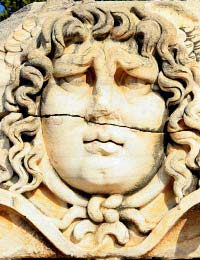The Monsters of Greek Myth

Not all of the Monsters of Greek Myth were monstrous, although many were. In many of the stories from Greek mythology creatures half animal and half man, or man -like but possessed of animal qualities, are prevalent, and not all of them are monsters. In most cases the various races of Greek Myth are similar to the gods and goddesses of Olympus, personifications of some aspect of life familiar to the Greek.
Anemoi - the Four Winds
The wind gods were known as the Anemoi, sometimes depicted as horses, sometimes as men with wings, others just as winds themselves. There were Boreas, the north wind, Notus, the south wind, Zephyrus,the west wind and Eurus, the east wind.Centaurs
The Greek myths were the origin of these half horse, half man creatures, which became very popular in medieval culture and in modern fantasy literature. Today considered wise scholars, many legends have them as lusty, troublesome tribes.Chthonic
Not a specific race, the Chthonic were in general "Earth gods", or simply a personification of earthy desires, such as lust.Cyclops
Often Cyclops is thought to refer to a specific entity out of Greek myth, but the figure in question, Polyphemus, was a member of the Cyclops race - so he was a Cyclops, not the Cyclops. These creatures were the sons of Poseidon, giants with one great eye, and shepherds by nature.Dragons
The Dragons of Greek mythology were more great serpents than the western Dragons of the middle ages; but they were prevalent monsters nonetheless.Erinyes - the Furies
Known as the Furies in Roman counterpart, the Erinyes were the personification of the anger of the dead - nothing to fool about with. While cast as the villain role in many stories, the Erinyes were more figures of justice than evil, haunting those who did dastardly deeds.Gigantes
Today these figures would simply be called Giants, and they were sort of like second rate Titans. Not immortal as the Titans were, nor as powerful as the gods and goddesses of Olympus, they nevertheless tried to take over and made war on Zeus and his family. They failed in their attempt.Gorgon
The most famous Gorgon was Medusa; because of this people might say "a Medusa" when they mean "a Gorgon." The classic Medusa was a woman with a head full of snakes for hair, whose gaze could turn a body into stone.
Nymphs
The Nymphs were female spirits linked in some fashion to the land, or the water. Nymphs were also where the Muses came from, nine spirits who specifically were linked to artistic endeavours and were said to inspire artists, writers, and musicians.Moirae - the Fates
The weavers of the thread of destiny, the Moirae, sometimes called the Fates, were those who had control over the destiny of everything - gods as well as men. Even Zeus feared them and was under their power.Harpies - the Snatchers
The Greeks had horse-men, and bird-women. These creatures had the bodies of birds and the upper bodies and heads of women. They were the personification of the spirit of death. While man creatures of Greek myth seemed to fill a role or have an agenda, the Harpies seemed to be used as dangerous creatures to be encountered, much as a bear or a lion, but more fearful.
Related Articles in the 'Gods & Godesses' Category...
- Athena, Brainchild of Zeus
- Harping on Hera, Wife of Zeus
- The Legend of Odysseus, plaything of the Greek Gods
- Hercules, the Hero of the Greek Pantheon
- Appreciating Aphrodite, the Greek Love Goddess
- Zeroing in on Zeus, Father of the Greek Gods
- Take up Arms with Ares, the Greek God of War
- The Olympians, Gods and Goddesses of the Greek
- The Titans, the Forerunners to the Greek Gods


Re: A Black Cat Crossing Your Path
For about 6 months i kept seeing cats crossing the road whilst i was working in care in the cimmunity the cats were mostly black…
Re: Do Birds Flying Into A Home Equate To Death?
So about a year ago I had two baby bird get in my room through the ceiling. I was in a shelter and the birds…
Re: Where Does the Name Nylon Originate?
I remember seeing a BBC documentary about Wallace Carothers, in which the New York-London idea was debunked. It seems…
Re: Do Birds Flying Into A Home Equate To Death?
Ive had a woidpecker. Pecking at my bedroom window. A few times in last couple wks. Then while i was camping…
Re: Spilling Salt
But if i throw some salt over my left shoulder and i get some under my nails, and then the salt falls out is it still considered bad luck? I ask…
Re: Women on Board Ship - Bad Luck
I'm 99% sure that the figurehead in the image at the top of this page is mine. It was attached to our 1930 wooden schooner but…
Re: A Black Cat Crossing Your Path
I saw two maybe three black cats on my porch one stood in front of my door way as I was knocking to get in I had no key so I…
Re: A Black Cat Crossing Your Path
A black cat came on my patio looked in my screen door at me and I made eye contact with it then it walked away. What does that…
Re: Spilling Salt
However I would like you to contact me and I need more explanation I need to understand more things and if it’s your desire to help Someone please…
Re: A Black Cat Crossing Your Path
Came on my front porch to a black cat lying in a broken chair not afraid of me or my kids at all ....is this bad